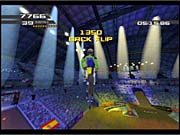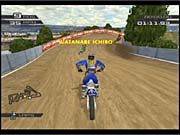There isn't a whole lot of freestyle motocross action to be found on the GameCube, though there are a couple of solid entries: THQ's MX Superfly and EA's Freekstyle each offer their own brand of high-speed, high-flying entertainment involving dirt bikes. Big Air Freestyle arrives not long after these games, yet both comparatively or purely on its own merits, it fails to deliver an enjoyable gaming experience.

Big Air Freestyle is a very lopsided game. Its unique physics system lets you pull off wild, impossible tricks--yet the game's most robust mode isn't its freestyle mode, but rather its season-based racing mode, where pulling tricks isn't necessary. In the season mode, you'll start with enough money to purchase a 125cc motorcycle and enter the first race. You'll earn money for completing races, and you'll use it repair your bike, enter the next race, and upgrade to a new race circuit at the end of the season.
The problem with the game's focus on the season mode is that it stands in complete opposition to the game's main draw--big air. The entire physics system feels like you're on the moon. Jumps will give you several seconds away from the ground, providing you with plenty of time to execute a number of tricks, backflips, barrel rolls, and the like. Of course, Big Air Freestyle rewards successful tricks with turbo boost, theoretically encouraging you to perform tricks during the races. But what the races really come down to is speed, meaning the more time you spend in the air after a jump, the less time you'll spend in control of your bike. It turns out that the best way to win races is to keep the bike on the ground as much as possible and race as consistently as possible, leaving the trick system alone entirely, which really isn't much fun at all.
The game fares a bit better in its freestyle mode. Unfortunately, there's just not much to do here. Each freestyle arena comes with a time limit and a score goal. If you reach the goal within the time limit, you'll unlock a new arena and a new "fantasy trick," but after you've completed all six arenas, there's nothing more to do. The trick system itself may be original, but it comes across as inaccessible and sloppy. Tricks are performed by holding the left trigger and executing button combinations. You can also hold the left analog stick left, right, or back to multiply the tricks with backflips or barrel rolls and maximize or minimize your airtime by shifting your weight backward or forward. As you progress through the different arenas, they get more challenging but no more rewarding. They are filled with obstacles like pitfalls and electrical traps, but you'll reap no greater satisfaction from completing one of the more difficult arenas--you'll merely be relieved that you won't need to play there again.
The game ends up feeling about as unfinished as it does unplanned, as it's also quite buggy. You'll occasionally fall out of levels, and on one particular occasion, lapping the last-place rider switched our race position from first to tenth. The split-screen multiplayer support is just a multiplayer adaptation of the game's basic gameplay, only with some pretty noticeable slowdown. The game's boundaries are pretty poorly executed as well. If you get caught executing a trick when you encounter one of the game's invisible walls, you will end up crashing and very slowly slide down the invisible wall before regaining control of your bike. Unfortunately, with all the time that you will be spending in the air with this game, you will be encountering these problems often.

Graphically, Big Air Freestyle doesn't bring much to the table. On the surface, it looks more like something you'd see on the PlayStation 2 than on the GameCube. All the rider models are the same, excluding some of the hidden characters, and all the bike models are the same too, even across the various classes. The animation of the tricks is really stiff and mechanical, which further reduces whatever satisfaction you might get from performing them. The audio is decent at best--most of what you will hear is the sound of the bike's engines. They sound pretty good, from the whiny 125s to the throaty 500s, but all in all, it's a fairly limited sound palette. The soundtrack will take good care of you if you're into modern pop-punk. It features a lot of bands like Sugarcult, MXPX, and 311, though it doesn't deviate far from that path.
In the end, Big Air Freestyle doesn't offer much that can be recommended. It's buggy, the gameplay modes are shallow, and the graphics don't save it. With games like MX Superfly and Freekstyle already on the market, there's simply no reason to give Big Air Freestyle a second look.



